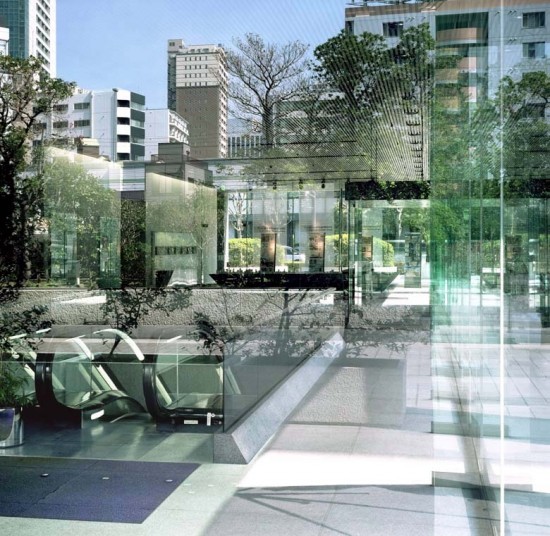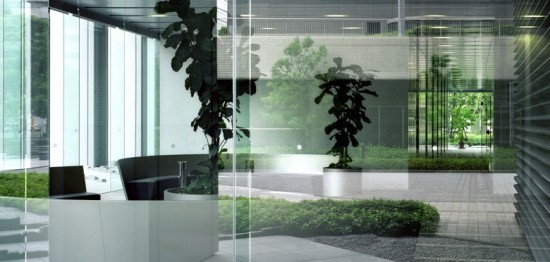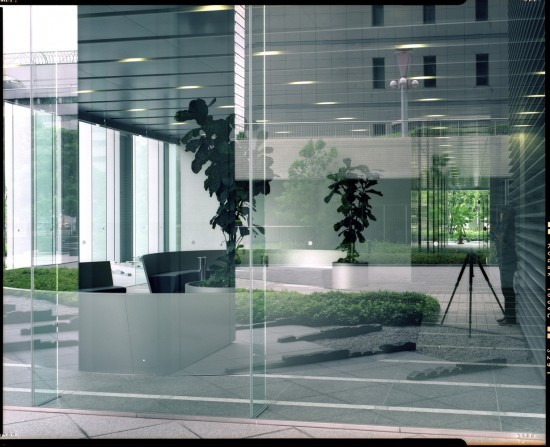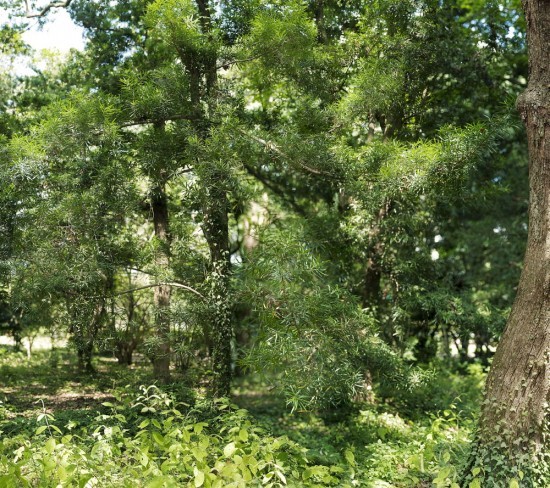Collage and Photography: Naruki Oshima’s New Series ‘haptic green’ (Part 1)

Reflections – 0606 (2006), Lambda print mounted on Plexiglas, 120 x 123cm, edition of 5. All images: Courtesy Gallery Nomart.
Having exhibited work at the International Architecture Biennale Rotterdam in 2003 and the photography section of the 9th Venice Architecture Biennale in 2004, and having collaborated with the Dutch architect Wiel Arets, Naruki Oshima (b. 1963) is actively engaged on the international stage. He is best known for his “reflections” series, consisting of photographs of the glass façades that now inundate urban architecture around the world.
The photographs in this series highlight the way these glass surfaces reflect surrounding objects, giving rise to a complex, layered effect. Oshima begins by photographing the glass façade with a large-format camera before digitally altering the results to remove the reflection of the photographer and adjust the color balance. This is more or less the full extent of the digital processing – there is no cutting and pasting of additional layers. Thus the perspective relationships are the same as those captured in the original analog photograph. This is evident when we compare the final result with the same photograph prior to digital processing.


Above: Reflections – in a scene of two plants (2004), Lambda print mounted on Plexiglas, 95 x 200cm, edition of 5. Below: The photograph prior to digital processing.
Here, let us call to mind the dualism of “theatricality” and “absorption.” In the case of theatricality – in which there is a given viewpoint with respect to the image plane and a distinction made between the “viewed subject” and the “viewer” – the viewer’s gaze is repulsed by the image and the only thing left remaining is “that which can be seen.” In the case of absorption, on the other hand, because the “viewer” becomes immersed in the subject and the gaze is drawn deeper and deeper into the image, there is no such “viewpoint.” Moreover, one is unable to see everything inside the image, which means that such photographs always have “unseen parts.”
Glass surfaces essentially reflect everything, including the “viewer,” and for this reason one could say they incorporate elements of the theatrical. At the same time, however, depending on the light conditions, the “surface” may become invisible and the glass disappear, and in this sense such surfaces are also absorptive. Furthermore, in Oshima’s works, because the photographer’s shadow (ie, the viewpoint) is removed, one could say the absorptive conditions are accentuated.
Next, Oshima manipulates the depth of the glass surface by adjusting the colors. The colors of things in the distance are subdued, giving them “the color of distant objects.” This is why people rarely bump into glass facades in the real world. However, Oshima adjusts and processes the background colors and the color of things behind the glass so that everything is brought to the surface. In other words, he manipulates the image theatrically by bringing to the fore things that were in the “distance.” As a result, the distance relationship of the glass surfaces (ie, layers) that present various reflections is severely disturbed. To use the example of sound, we recognize distance not by a volume (distant = soft; near = loud) but by changes in tone (distant = distant tone; near = near tone). Because sound is determined by its harmonic arrangement, in the case of pure tones with no overtones (sine waves) we are unable to perceive whether a sound is near or far. This is why digital beeping sounds seem strangely near regardless of where we are in relation to them. So by genuinely equalizing the colors of the overlapping layers, Oshima disturbs our ability to perceive the scene’s depth.
These two manipulative processes could be described as manipulations that cancel out absorption and theatricality – that is, the “invisible” and the “visible.” However, in this cancelling out there is expressed something akin to the paradox of the age in which we live in that the “transparency” and “openness” symbolized by glass façades, or in their visual and social “visibility,” simultaneously changes into invisibility. Perhaps Oshima is using the motif of glass façades to express the peculiar absorption of our age, an age flooded with vast quantities of information, whereby rather than individuals immersing themselves in that which lies in the distance, that which was in the background comes to the surface, engulfing the individual in the thick of visibility. It is possible to see in glass façades a style of architecture that is “invisible” because it is “too visible,” a style characterized by an invisibility born out of visibility: a new kind of absorption.
“Reflections,” then, is a series that makes it all but impossible to determine the context of the multiple layers created by the glass façades. As photographic works they each consist of a single layer only. In contrast to this, “haptic green” is a series in which each of the subjects is divided into hundreds of layers before being reintegrated. Moreover, in most cases these layers are connected in a lattice-like fashion without overlapping.

haptic green – pi.k.k.01 (2011), Lambda print mounted on Plexiglas, 120 x 135cm, edition of 5.
After choosing the scene he wants to capture, Oshima positions his camera and photographs it almost as though taking a scan, taking a series of cuts starting at the bottom-left corner and moving to the right, finishing at the top-right corner. Furthermore, with each cut he randomly adjusts the focal length, depth of field and so on. Each work is finished by joining together over 200 such cuts and digitally processing them to remove the distortions of the surrounds caused by the angle of the fixed camera, and to hide the joins between the cuts. So each single scene is reconstructed from over 200 fragments. For some people, this probably calls to mind cubist painting or collage. At the same time, however, the differences between Oshima’s creative method and cubism are clear. In cubist painting, it appears as if square layers much like frames of film of a single object shot from various angles and distances have been collaged, giving them the appearance of reconstructions of three-dimensional objects using transparent layers. In contrast, the images in “haptic green” are made by collaging layers made by photographing a single scene from the same angle and distance but using different focal lengths and depths of field. In other words, they are not reconstructions of three-dimensional objects, but relate to our perception of the scene before our eyes, or what Maurice Merleau-Ponty calls “primordial depth.”(1) (To be continued)
Naruki Oshima’s “haptic green” was on display at Gallery Nomart, Osaka, from November 5 to December 3, 2011.
-
“As we pointed out at the beginning, we have to rediscover beneath depth as a relation between things or even between planes, which is an objectified depth detached from experience and transformed into breadth, a primordial depth, which confers upon the other its significance, and which is the thickness of a medium devoid of anything.” Maurice Merleau-Ponty, Phenomenologie de la perception. (Paris: Gallimard, 1945), trans Colin Smith under the title Phenomenology of Perception (New York: Humanities Press, 1962; London: Routledge & Kegan Paul, 1962; trans revised by Forrest Williams, 1981; reprinted, 2002), p. 310.
Archive
Critical Fieldwork: Observations on Contemporary Art in Japan 1-6
